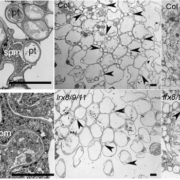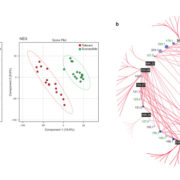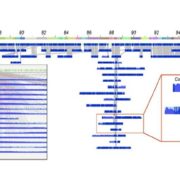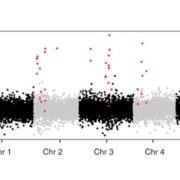
LRX Proteins play a crucial role in pollen grain and pollen tube cell wall development
Blog, Plant Science Research Weekly, Research, Research BlogLeucine-rich repeat extensins (LRXs) are proteins involved in cell wall growth and are therefore required for plant growth processes. Fabrice et al. use pollen tube development in Arabidopsis thaliana as a vegetative plant growth model to elucidate the role of LRXs in these cellular processes. All 4…

Disruption of actin filaments in Zea mays by bisphenol A depends on their crosstalk with microtubules
Blog, Plant Science Research Weekly, Research, Research BlogBisphenol A (BPA) is known for its negative impact on mammalian cell lines and, recently, as an emerging environmental pollutant. BPA, readily taken up and metabolized by plants, results in many growth and developmental defects, from disrupted mitotic microtubule (MT) arrays to altered calcium fluctuations…

Ash leaf metabolomes reveal differences between trees tolerant and susceptible to ash dieback disease
Blog, Plant Science Research Weekly, Research, Research BlogOver the last two decades, Ash dieback (ADB) has been sweeping through Europe killing or damaging a large proportion of European common ash trees (Fraxinus excelsior). ADB results from infection by wind borne spores of the fungus Hymenoscyphus fraxineus. As ADB spread and the scientific research…

Arabidopsis thaliana plants lacking the ARP2/3 complex show defects in cell wall assembly and auxin distribution
Blog, Plant Science Research Weekly, Research, Research BlogThe plant cytoskeleton determines cell shape and integrity by delivering cellulose microfibrils and other cell wall components to the plasma membrane and cell wall. Auxin is involved in establishing the polarity of cell expansion and auxin distribution is partly regulated by actin. Sahi et al. examine…

Commentary: Is it ordered correctly? Validating genome assemblies by optical mapping
Blog, Plant Science Research Weekly, Research, Research BlogOne of the hardest parts of any sequencing project is putting the pieces together. Physical sequence alignments can be cross checked against genetic linkage maps when they are available, but what about for species without genetic linkage data? Udall and Dawe describe the use of optical mapping, using…

Evolution of transposon-encoded anti-silencing factors in Arabidopsis ($)
Blog, Plant Science Research Weekly, Research, Research BlogTransposable elements (TEs) are a major component of eukaryotic genomes. Their activity is silenced by epigenetic mechanisms such as chromatin modifications and DNA methylation in order to avoid deleterious effects on host genome stability. Nevertheless, how TEs overcome silencing by the host and propagate…

What We're Reading: January 5th
Blog, Research, Research Blog, WWR Full PostGuest Editor: Alecia Biel
Alecia is a graduate student at The Ohio State University in the US and has been a Plantae Fellow since September 2017. Her research focuses on elucidating hormone signaling pathways and the role of the nucleus during this process, particularly throughout plant abiotic…

KNS4/UPEX1: A Type II Arabinogalactan β-(1,3)-Galactosyltransferase Required for Pollen Exine Development
Blog, Plant Science Research Weekly, Research, Research BlogPollen is an essential component in angiosperm reproduction. Pollen grains are surrounded by a highly resistant wall called exine which enables survival of the male gametes in adverse environmental conditions. Suzuki et al. examined the contribution of an Arabinogalactan β-(1,3)-Galactosyltransferase…

An oomycete plant pathogen reprograms host pre-mRNA splicing to subvert immunity
Blog, Plant Science Research Weekly, Research, Research BlogPhytopthora sojae poses a serious threat to soybean production world-wide. This oomycete pathogen has a wide arsenal of effector proteins, some of which have been functionally characterized for their virulence role. Huang et al. characterized and demonstrated the functional role of an avirulence effector…

